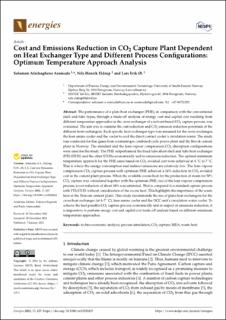| dc.contributor.author | Aromada, Solomon Aforkoghene | |
| dc.contributor.author | Eldrup, Nils Henrik | |
| dc.contributor.author | Øi, Lars Erik | |
| dc.date.accessioned | 2022-08-16T09:07:14Z | |
| dc.date.available | 2022-08-16T09:07:14Z | |
| dc.date.created | 2022-05-09T13:52:44Z | |
| dc.date.issued | 2022 | |
| dc.identifier.citation | Energies. 2022, 15 (2), 1-40. | en_US |
| dc.identifier.issn | 1996-1073 | |
| dc.identifier.uri | https://hdl.handle.net/11250/3012041 | |
| dc.description.abstract | The performance of a plate heat exchanger (PHE), in comparison with the conventional shell and tube types, through a trade-off analysis of energy cost and capital cost resulting from different temperature approaches in the cross-exchanger of a solvent-based CO2 capture process, was evaluated. The aim was to examine the cost reduction and CO2 emission reduction potentials of the different heat exchangers. Each specific heat exchanger type was assumed for the cross-exchanger, the lean amine cooler and the cooler to cool the direct contact cooler’s circulation water. The study was conducted for flue gases from a natural-gas combined-cycle power plant and the Brevik cement plant in Norway. The standard and the lean vapour compression CO2 absorption configurations were used for the study. The PHE outperformed the fixed tube sheet shell and tube heat exchanger (FTS-STHX) and the other STHXs economically and in emissions reduction. The optimal minimum temperature approach for the PHE cases based on CO2 avoided cost were achieved at 4 °C to 7 °C. This is where the energy consumption and indirect emissions are relatively low. The lean vapour compression CO2 capture process with optimum PHE achieved a 16% reduction in CO2 avoided cost in the cement plant process. When the available excess heat for the production of steam for 50% CO2 capture was considered together with the optimum PHE case of the lean vapour compression process, a cost reduction of about 34% was estimated. That is compared to a standard capture process with FTS-STHX without consideration of the excess heat. This highlights the importance of the waste heat at the Norcem cement plant. This study recommends the use of plate heat exchangers for the cross-heat exchanger (at 4–7 °C), lean amine cooler and the DCC unit’s circulation water cooler. To achieve the best possible CO2 capture process economically and in respect of emissions reduction, it is imperative to perform energy cost and capital cost trade-off analysis based on different minimum temperature approaches. | en_US |
| dc.language.iso | eng | en_US |
| dc.publisher | MDPI | en_US |
| dc.rights | Navngivelse 4.0 Internasjonal | * |
| dc.rights.uri | http://creativecommons.org/licenses/by/4.0/deed.no | * |
| dc.subject | waste heat | en_US |
| dc.subject | MEA | en_US |
| dc.subject | CO2 capture | en_US |
| dc.subject | process simulation | en_US |
| dc.subject | techno-economic analysis | en_US |
| dc.title | Cost and Emissions Reduction in CO2 Capture Plant Dependent on Heat Exchanger Type and Different Process Configurations: Optimum Temperature Approach Analysis | en_US |
| dc.title.alternative | Cost and Emissions Reduction in CO2 Capture Plant Dependent on Heat Exchanger Type and Different Process Configurations: Optimum Temperature Approach Analysis | en_US |
| dc.type | Peer reviewed | en_US |
| dc.type | Journal article | en_US |
| dc.description.version | publishedVersion | en_US |
| dc.rights.holder | Copyright: © 2022 by the authors. Licensee MDPI, Basel, Switzerland. This article is an open access article distributed under the terms and conditions of the Creative Commons Attribution (CC BY) license (https:// creativecommons.org/licenses/by/ 4.0/). | en_US |
| dc.source.pagenumber | 1-40 | en_US |
| dc.source.volume | 15 | en_US |
| dc.source.journal | Energies | en_US |
| dc.source.issue | 2 | en_US |
| dc.identifier.doi | 10.3390/en15020425 | |
| dc.identifier.cristin | 2022729 | |
| dc.source.articlenumber | 425 | en_US |
| cristin.ispublished | true | |
| cristin.fulltext | original | |
| cristin.qualitycode | 1 | |

